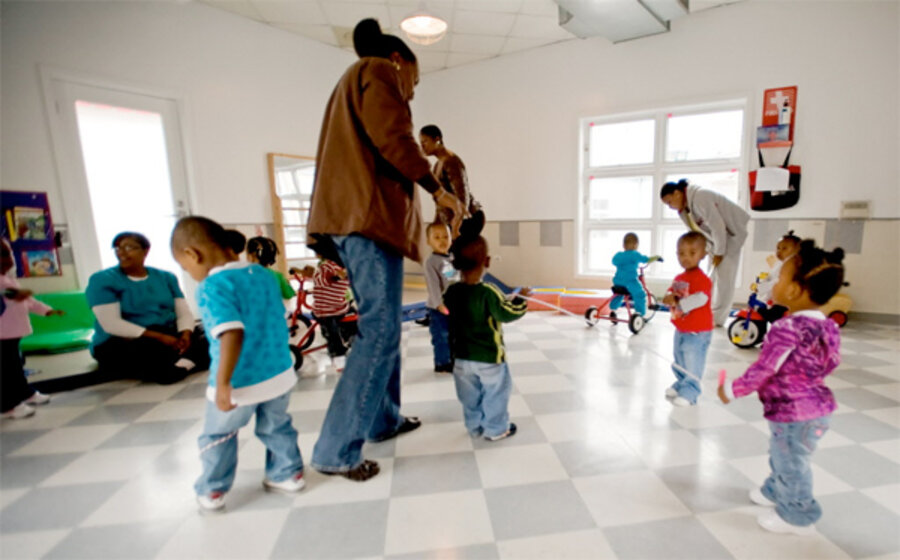Childcare cost: Day care expense rivals college cost, fuels social problems
Loading...
Forget saving for college. These days, parents – and parents-to-be – should be stashing away funds for day care.
According to a new study from ChildCare Aware of America, a childcare research and advocacy group, center-based care for an infant costs more, on average, than in-state tuition at a four-year public college. The price tag ranged from about $4,600 in Mississippi to $15,000 in Massachusetts, and was more than annual median rent payments in 22 states. In some of the more expensive states the cost of day care for infants equals about half of the median income for single moms.
And those numbers drop only slightly for children four and older.
“Parents are tapped out,” says Grace Reef, chief of policy and evaluation for ChildCare Aware of America. “They really can’t pay more. It’s not affordable.”
So what does this mean? Over the past week or so, Modern Parenthood has been talking with a number of family and children advocates about the cost of childcare, as well as with a handful of parents. The high price of care, it turns out, often blindsides new parents, and has ripple effects that impact everything from a family’s debt situation to glass ceiling wages to that whole Mommy Wars debate between working and stay at home moms. (Which really starts to look silly in the face of all of this, I might add.)
Ponder, for instance, this fact, shared by Kristin Rowe-Finkbeiner, co-founder and chief executive of MomsRising.org, a social media site and advocacy group that boasts over a million mom members: Having a new baby is one of the top reasons for a “poverty spell,” the term for what happens when your income dips below what’s needed for food and rent.
The key factor in that “spill” is infant care. Without a paid maternity leave policy the US (reminder – we’re the only developed country in the world that rolls this way), and with only a percentage of employees qualifying for unpaid leave, many moms need to either put baby into day care as soon as possible or quit their jobs. This means a huge drop in income. Add another child and the situation becomes even more dire.
“Infant child care is among the most expensive childcare on the planet,” Ms. Rowe-Finkbeiner says. “If you have a baby and you don’t have access to childcare, you’re starting in a hole.”
Although the federal government distributes money to states to be used for child care subsidies for lower income families – this is called the Child Care and Development Block Grant – only one in six eligible children receive any money because of lack of funding. (In Maryland there are 19,000 kids on the waiting list for child care subsidies.) And other programs, from Head Start to child care tax credits, also either reach only a fraction of those in need, or provide only a tiny bit of relief, says Helen Blank, director of leadership and public policy with a focus on child care and early learning at the National Women’s Law Center.
“The bottom line is that we don’t have a good set of supports for moms who need to go to work and for children who need child care,” Ms. Blank says. “It’s quite an outrage that in a country that values work and wants children to be successful, and is worried about our educational system, that the child care system is such a weak link.”
So what does this all mean for strapped and stressed out families, in practical terms? We’d be happy to hear your stories. But we know that millions are either compromising on care or struggling to patch together various arrangements.
Rowe-Finkbeiner says she hears stories of parents taking opposite shifts so dad can care for baby while mom is at work, and the other way around; about elderly grandparents stepping in to help; about parents opting – because of cost – for less expensive, but unregulated and unlicensed, informal family day cares.
“People patchwork all sorts of things that aren’t the best or safest for the kid, but are out of necessity,” she says.
The challenge, everyone we talked to acknowledged, is that there is no easy solution to this – at least not with a major shift in public policy.
See, there’s a major Catch-22 in the child care cost problem. The main reason for the high cost of care, advocates say, is the salary expense for day care centers. But child care workers are some of the lowest paid professionals in the American workforce. You can’t reduce costs, and you can’t charge more.
At the same time, many of the same advocates who decry the impact child care expenses have on families are pushing for an increase in the quality of care. This usually means better licensing, regulations and oversight, as well as requirements for a better educated workforce. But these changes would clearly make child care costs go up even further.
“It’s a huge dilemma,” Reef says. “The current system is not working.”








